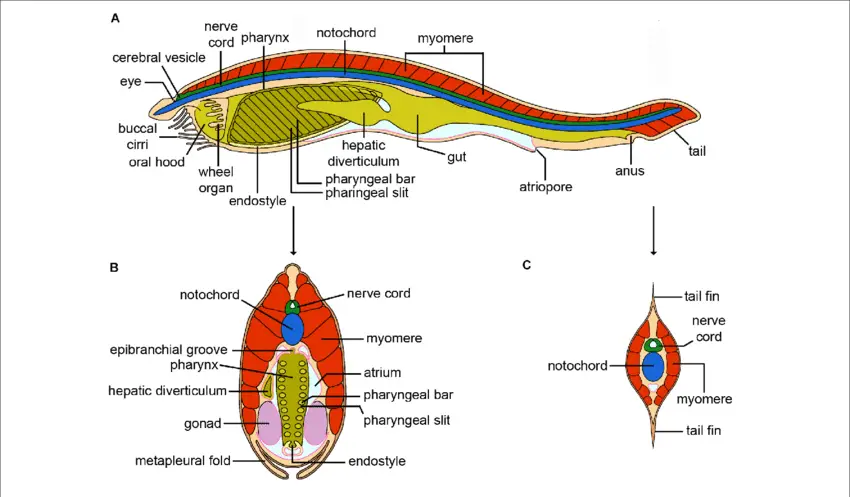Table of Contents
Digestion in Branchiostoma:
In Branchiostoma the alimentary canal is complete and it has associated glands to perform the digestion process.
Digestive Glands In Branchiostoma:
On the ventral side the at the junction of the esophagus and midgut a blind sac tubular structure arises and extends in a forward direction on the right side into the atrial cavity. This blind sac extension of the gut is known as the midgut diverticulum which acts similarly functions as that of the liver so it is considered as liver and it is the largest digestive gland in the digestive system of Branchiostoma.
The ciliated groove present inside the narrow coelom of the midgut diverticulum is responsible for the proper flow of food in the alimentary canal. The zymogen cells present in the epithelium of the midgut diverticulum and some glandular cells present on the lining of the intestine secret digestive enzymes which takes part in the digestion of food.

Food of Branchiostoma:
Branchiostoma takes different microscopic organisms present in ocean water as food, the diatoms, plankton, protozoan is the food of Branchiostoma, the food particles present in ocean water enter into the body of Branchiostoma through the food cum respiratory water current.
Feeding Mechanism of Branchiostoma:
Branchiostoma takes food and respiratory gases through the water current generated by the cilia present on the wheel organ of Branchiostoma. The water current enters through the mouth opening and is filtered by the buccal cirri present along with the oral hood, finally the water current pass outside through the atriopore.
The filtration of water current occurs two times in the alimentary canal of Branchiostoma, first the buccal cirri filter the water current and prevent the entry of large particles. When the water current reaches Enterostome, the velar tentacles present on the velar membrane again filter the water current to prevent the entry of larger particles.
Branchiostoma is able to detect the chemical nature of water current and the food particles present in the water current due to the presence of sensory structure present on buccal cirri and on velar tentacles.
The food particles present on the water current trapped in the mucous secreted by the Hatschek’s groove and Hatschek’s pit, the mucous wrapped food particles are then sent to the pharynx through the Enterostome.

During the inflow of water current, the atriopore remains closed and the sudden construction of transverse muscle present on the floor of the atrium cause and reback of water current through the Enterostome and mouth, it helps to remove the large particles attached to the buccal cirri and velar tentacles. Then the water enters into the atrial cavity from the pharynx and through the gill slits present on the pharyngeal wall and goes outside through the atriopore.
The food particles reached in the pharynx remain trapped in the mucous secreted by the pharyngeal wall which creates a thread-like mucous cord. The cilia present on the lateral wall and floor of the pharynx lead the food particles towards the dorsal region of the pharynx. The food present in the mucous cord gets directions by the cilia present on the epipharyngeal groove, the cilia present on epipharyngeal groove beat backward direction which leads the mucous thread into the esophagus from the pharynx.
Digestion of Food in Branchiostoma:
The food reaches the esophagus from the pharynx and from the pharynx to the midgut. From the midgut, the food enters into the midgut diverticulum and comes back to the midgut again. The digestive enzymes secreted from the epithelial cells of the midgut and midgut diverticulum mix with the food and digest the food. The food cord when reach at the ilio-colic ring the food particles break into smaller sizes and the food particles get enough time for complete digestion.
Digestion generally occurs through extracellular digestion through the digestive enzymes but some phagocytic cells present in the midgut diverticulum take part in intracellular digestion.
Digestive Enzymes in Branchiostoma:
In Branchiostoma the epithelium of the midgut and the epithelial zymogen cells of the midgut diverticulum secrete digestive enzymes like amylase, lipase, and protease but pepsin is absent in Branchiostoma.

Absorption of Food:
Digested food molecules are absorbed by the epithelium of the hindgut, absorption also occurs in minor amounts in the midgut also. Some food that enters into the atrial cavity is engulfed by the phagocytic cells present in the atrial cavity in which the food undergoes intracellular digestion, the undigested food goes outside through the anus.
Reference
Detailed Information on
Characteristics Features of Subphylum Urochordata
Classification of Subphylum Urochordata
Examples of Subphylum Urochordata: Clavellina, Salpa, and Doliolum
Examples of Subphylum Urochordata
Branchiostoma Habitat and Geographical Distribution
External Morphology of Branchiostoma
Body Wall and Endoskeleton of Branchiostoma
Hi Everyone!!! Welcome to Imaluop. Imaluop always try to learn some new and he want to share to other people. Here we will try to learn various topics on Science, specially on Biological Sciences.